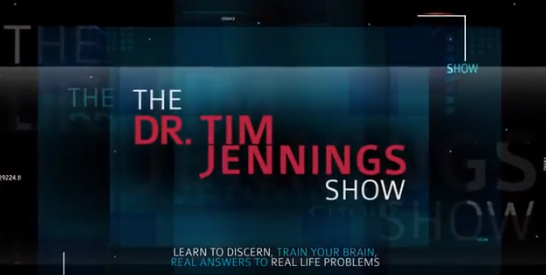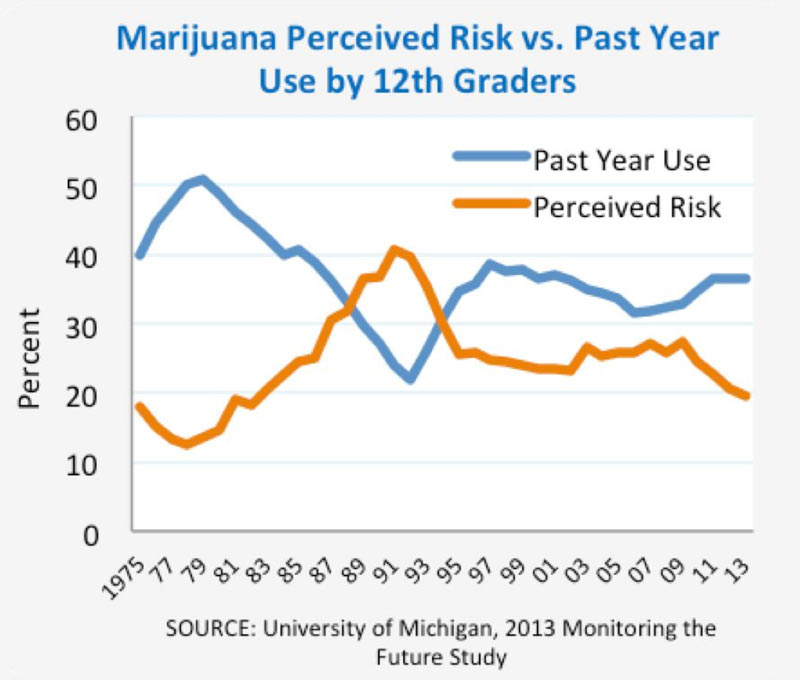Dr. Jennings discusses the seven level of moral decision-making detailed in his new book, The God-Shaped Heart, How Correctly Understanding God’s Love Transforms Us.
Time

Dr. Jennings discusses the seven level of moral decision-making detailed in his new book, The God-Shaped Heart, How Correctly Understanding God’s Love Transforms Us.

Psychiatrist, Dr. Tim Jennings, discusses how to have a healthy mind, how to exercise and strengthen the three mental attributes everyone possesses, and how to overcome fear and heal emotional pain.
Tim Jennings

Twenty-eight states and the District of Columbia have legalized “medical marijuana” and 8 states have legalized recreational cannabis use. Does this mean that marijuana is harmless? That it is safe? That it is not addictive? What does the science actually reveal?
• Cannabis is the most commonly used illicit substance in the United States and worldwide.
• Cannabis is addictive and the younger one starts using it, the greater the likelihood of addiction.
o One out of eleven (9%) adults who try cannabis become addicted.
o One out of six (17%) adolescents who try cannabis become addicted (Hall, 2009; Volkowet al., 2014).
Cannabis has changed over the years and is much more potent today than just a few decades ago, thus increasing the risk of addiction, as well as mental health problems. In 1992, the average potency of delta-9-tetrahydrocannabinol (THC) in seized cannabis was 3% but by 2019 the potency had increased to 11%–an almost fourfold increase! And this increase in potency correlates with increased number of hospital admissions for cannabis use disorders.
Cannabis contains more than 460 active chemicals and more than 100 unique cannabinoids. These are the compounds that interact with the brain’s cannabinoid receptors.
Cannabis (including “medical marijuana” in dispensaries) is not standardized in dose, potency, or chemical constituency, which means you don’t know what you’re getting from one marijuana sample to the next.
So, what does the published research demonstrate?
• Most studies (70%) done on cannabis are deemed to have “high-risk of bias” due to methodological flaws and author biases.
• Only 57% had appropriate participant blinding and only 24% with appropriate blinding of outcome assessors. (This means preventing the participants and assessors from knowing who was getting real cannabis and who was getting placebo.)
• Most research was done on oral cannabinoids, which contained only one or two of the more than 100 active compounds; only two studies involved actual cannabis (smoked in one study, vaporized in another.)
• Thus, all the hype suggesting safety of cannabis is just that, hype and not science.
Of the studies that were well done, the researchers concluded that there was moderate evidence of medical benefit from cannabis for chronic pain and muscle spasticity. There was poor-quality evidence for the treatment of nausea/vomiting due to chemotherapy, weight gain in HIV, sleep disorders, and Tourette syndrome.
This means that the medical benefits are narrow and much more evidence is needed. However, since many states have legalized medical marijuana, it has led to the perception amongst young people that marijuana is not harmful.
The graphic below demonstrates how attitudes among high school students have changed from 1975 to 2013:

Another issue that perpetuates the false idea that marijuana is harmless is that it is “natural.” But natural doesn’t always mean harmless! Consider tobacco, poison ivy, poison mushrooms or foxglove (a plant from which the cardiac medicine digoxin is derived, and small overdose of it will stop the heart). All of these are natural products but are poisonous or toxic. No, natural doesn’t always mean harmless.
Perception about marijuana is critically important and we must educate young people about the health damaging effects of it, just as we have done regarding tobacco.
Surveys show that 45% of U.S. high school seniors have used marijuana, 23% use currently, and 6% use daily (Johnston et al., 2016). The more marijuana is used the more damage it does to the brain. In a dose-dependent manner, adolescent cannabis use is associated with worse performance in school, work, thinking, increased psychiatric disorders, and worsened substance use outcomes (Pope et al., 2003; Fergusson et al., 2015, Jager& Ramsey, 2008; Meier et al., 2012; Randolph et al., 2013; Camchonget al., 2016, Fergusson et al., 2002; Patton et al., 2002; Moore et al., 2007, Patton et al., 2007.Volkowet al., 2014, 2016; Levine et al., 2017).
Cannabis use in adolescence is associated with increased incidence and worsened course of psychotic, mood, and anxiety disorders (Hayatbakhshet al., 2007; Moore et al., 2007; Gage 2016).
Several studies have documented that adolescents who smoke marijuana have a loss of IQ points, more than a standard deviation, that is never fully recovered after stopping the marijuana (Pope 2003, Gruber 2011, Meier 2012).
The bottom line is that marijuana is a neuro-active substance that has multiple damaging effects on the brain. It reduces IQ, increases mental illness and increases the risk of multiple health problems. Furthermore, there is essentially no research on the more than 400 chemical compounds contained within cannabis.
We must move away from myth to truth and educate our young people on the dangers of this substance.
Remember, humans can pass laws to make marijuana legal—but we can never pass laws to make it healthy! Mature people are those who choose to operate in harmony with design law—the laws upon which life and health are built—so even when society makes something legal, if it is unhealthy, the mature wont damage their bodies with it.

Psychiatrist, Dr. Tim Jennings, introduces himself and explains his profession before expanding on the principles of his “evidence-based approach to decision making” process and application.
text here


This week, I received an email with this question: “How can I find a counselor in my area that reasons and believes as I do?”
I am often asked to recommend a counselor, therapist, or psychiatrist for people living in various locations throughout the country. I have made it a policy not to recommend a specific provider unless I know him or her personally. However, the following are some guidelines you can use to find a mental health provider in your area best suited to your needs.
1. Determine what level of provider you need:
2. Identify other factors in your decision-making:
3. Determine any other variables important to you:
4. Get input from trusted sources:
5. Once you have the answers to the above, it’s time to make a decision:
Finally, in your initial appointment, not only is the provider evaluating you, but you are also to be evaluating them. Ask any questions you have about their methods, beliefs, values, policies, etc. Assess your comfort with them, then decide whether this provider is a good fit for you or not. If not, then go to another until you find one with whom you are comfortable working.
If you end up with a therapist that suggests an activity, intervention, or “therapy” that makes you uncomfortable, ask the provider to explain the rationale behind the recommendation, any evidence to its benefit, and the potential risks. If you are still unsure, tell the provider you will have to think about it. Then go home, do some research, get input from others, and then decide whether that therapy and therapist are right for you.
And don’t forget to pray for wisdom and God’s guidance in this selection process!

Have you ever struggled with loneliness? Have you ever been in a room full of people but felt isolated, disconnected, alone? Have you been tormented by an uneasiness within, a feeling that something isn’t right, a restless longing to fill some emptiness deep inside? And have you tried to fill this void, to find relief in television, video games, shopping, alcohol, drugs, sex, or allowing others to take advantage of you, just so they will like you—so you won’t be alone—yet the emptiness, loneliness, and uneasiness never go away?
If this describes your experience, don’t be discouraged; don’t accept the feelings as facts; don’t believe the lies that pound away inside your head. There is freedom; there is a healing solution. The truth will heal. The truth will set you free. And what is the truth?
YOU are loved! You are loved for who you are, because you are a child of God!
Our worth, our value, is not determined by what we have done or what we will do, but by who we are—we are children of God, created by him to love and to be loved.
If you have struggled in your life to experience this love, if you have tried to read the Bible but found it hard to understand, filled with terms that seem legal or even harsh, then I invite you to explore God’s love in The Remedy New Testament an Expanded Paraphrase, which you can read for free here on our website (click here)—or you can get The Remedy app (click here) in your app store or as a printed softcover book on Amazon (click here).
In The Remedy, you will discover God’s remedy for your soul—His infinite, constant, never-ending love. God’s love is real; it is powerful and life-changing, and God’s love is poured out for you! Drink it in and you will never be lonely again!

According to the Centers for Disease Control and Prevention, 13 out of every 100,000 people will die by suicide. Most people have been impacted by this tragedy in one way or another, including me. Several years ago, after the death of his wife of fifty years, my great uncle ended his own life; he was simply unable to cope with the heartache, pain, and loneliness.
As a psychiatrist, I know all too well how the severely depressed can be overwhelmed by thoughts of suicide. I also know that in the aftermath of a suicide, those who loved the victims struggle with their own faith and worry that they will not see their loved ones in heaven.
This subject recently roared back into my mind when I received an email from a concerned parent who listens to our program online. He wrote to tell me that his daughter attends a Christian high school where another student had committed suicide. I can’t imagine the heartache that young man’s family is now going through, and my prayers and thoughts go out to them.
However, adding to this heartache, the daughter of our listener—along with other students and even some of the faculty—was struggling because she’d been told that the young man had committed an act of sin in the taking of his own life. He was even compared to Judas, and the students were told that because he, like Judas, committed suicide, he would be eternally lost.
I don’t condemn those who said these things, but it’s important to set the record straight about this unfortunate falsehood—a lie that misrepresents a loving God, one that likely injured vulnerable young people who are searching for meaningful answers in their grief. Because I fear such a misrepresentation will turn some of these students away from God, I believe it’s vital to address this subject.
The Real Reason Judas Was Lost
Judas is not eternally lost because he committed suicide; he is eternally lost because he rejected Jesus. Without Jesus, he became overwhelmed by guilt and committed suicide to escape this unbearable burden. Judas is not an example of what happens to those who commit suicide—he is an example of what happens to those who reject Jesus.
If we use the logic of those who hold Judas up as evidence that those who commit suicide are lost, we must then conclude, that, if like Samson, a person commits mass murder while committing suicide—they will be saved. After all, Sampson was reconciled to God and received supernatural strength to end his own life and the thousands in the temple with him. It’s clear that suicide bombers today don’t go to heaven because they killed others while killing themselves, even in the name of religion.
Death by suicide does not determine one’s eternal destiny. Why? Because suicide is almost always a symptom of an illness, a problem, or overwhelming distress—and not an act of sin, not a willful rebellion against God. Instead, suicide almost always happens when a person is in some type of horrible pain in which they lose all hope of escape. In that mindset, suicide becomes their only perceived avenue of escape from the pain. We help those who are struggling with thoughts of suicide by offering hope—the hope of escape from their pain. We help identify the source of the pain and provide real interventions that restore them to wellness. Sadly, though, not everyone realizes these other options of escape are available—and some, like my great uncle, succumb to suicide.
Many factors contribute to people finding themselves at increased risk of suicide—some of which the individual has no control over. Age, race, birth month, socioeconomic status, marital status, relationship stress, mental illness, physical illness, genetic vulnerabilities, geographic location, lack of sunshine, pollution, infections, trauma, and intoxicating substances—these are all factors that contribute to increased risk for suicide.
In our human experience, almost everyone has times of pain, heartache, discouragement, and hopelessness in which the idea that death might be better than life occurs. Even great heroes of God—remember Elijah?—can struggle with such discouragement. Yet we must remember that with God there is always hope, a hope based on a real God with real resources to heal and restore!
The Source of the Lie
From where does this idea that suicide is an act of sin that results in eternal loss come? It comes from accepting the lie that God’s law functions like human law—a system of rules with no consequence other than the ruling authority keeps track of what laws were broken and then punishes lawbreakers. For those who believe this way about God’s law, sin becomes all about behavior—the acts and deeds. The wrong deed or act, in this way of thinking, requires the direct infliction of punishment. Such thinking promotes this idea that God, rather than being merciful to the teen who lost the struggle against depression, hopelessness, and pain, will then inflict further torture and pain upon him as punishment for having committed suicide.
When we return to the truths that God is our Creator and His laws are the protocols upon which life and health are constructed to operate, we realize that deviations from His designs result in pain, suffering, and death. We understand that all nature groans under the weight of sin (Romans8:22). This means our physical condition can groan under the weight of mental illness, which can express itself as a variety of symptoms—including suicide. We realize that suicide is a symptom of other issues and not an act of deliberate rebelliousness and sin.
We can also know that God is constantly working to heal and restore His children.
So the questions we need to ask are: What is the condition of the heart of those who are suffering suicidal thoughts? Are these people like Elijah, a champion of God, whose heart was right with God, yet who suffered emotional discouragement, depression, and suicidal thinking? Or are their hearts like Judas, consumed with selfishness and who reject Jesus?
Suicide is a tragedy; it is never the best answer to a problem. In my practice, I often treat suicidal patients. My goal is to help them realize that what they almost always truly want is to escape their pain and not to die. Then I offer them other avenues of escape. And when they experience resolution of their pain, the suicidal thoughts resolve.
For those who have found themselves trapped in some situation, spiraling down into a pit of despair and who were unable to see other options of escape, and have died by suicide—what then? We must realize that such an act does not mean eternal loss. In these situations, we need to offer hope to those suffering from such loss; we must promote the truth about our God of love, and realize, that like Sampson, it isn’t how one ends their life on earth that determines their eternal destiny—it is whether or not they loved Jesus that determines their eternal destiny.
If you or someone you know is suffering from suicidal thoughts, please call the national suicide prevention hotline at 1-800-273-8255.
Winston Churchill said, “There is nothing to fear except fear itself.” Have you ever wondered about that famous statement? Imagine walking a four-inch wide balance beam placed securely on the ground, your feet only a few inches from the dirt. Now imagine walking that same beam raised 100 feet in the air. Would your ability to successfully traverse the beam be negatively affected as you look down from such a height? What changed? Fear!
When we are afraid, the brain’s fear circuit (amygdala) activates, which floods the body with surges of stress chemicals (adrenalin and glucocorticoids). We experience the classic “fight or flight” response in which blood is shunted from our internal organs to our muscles and glucose is dumped into the blood stream. This is to bring us to quick attention in the face of an external threat, like the house being on fire. However, chronic fear, fear of failure, fear of rejection, fear of what others think, fear of financial ruin, and chronic worry of any kind keeps the fear circuits firing, which activates the body’s immune system, increasing inflammatory factors that injure our bodies. Under chronic fear, worry, and stress these inflammatory factors damage insulin receptors, increasing the risk of diabetes mellitus, obesity, high cholesterol, heart attacks, and strokes.
Chronic fear also impairs growth of all types. A recent study documented that Iraqi children growing up in war zones were measurably shorter than Iraqi children growing up in rural safe zones. Fear impairs physical growth![i]
Maybe you have known someone with test anxiety or someone who froze when getting up in front of an audience. What happened? Their fear circuits fired, paralyzing their prefrontal cortex (thinking circuits). Intellectual and cognitive growth is impaired when we are afraid.
When something really frightens you, like smelling smoke as someone yells fire in a theater, where does your focus turn? Do you become more concerned with the strangers in the room or more concerned with saving self? The more fearful we become, the more self-focused we become. Fear impairs relational growth!
When we believe God concepts that incite fear, the ability to grow spiritually is impaired. It is in the prefrontal cortex (located right behind the forehead) where we reason, plan, organize, focus, concentrate, and self-restrain. It is also in the prefrontal cortex where we have our conscience, redirect inappropriate behavior, and worship. A special part of the frontal cortex, called the anterior cingulate cortex (ACC) is our neurological “heart.” It is here where we experience altruistic love and empathy. The ACC is also the seat of the will, the place we choose right from wrong. The proverb, “As a man thinks in his heart so is he” (Proverbs 23:7) is referring to the ACC.
Amazingly, brain research has demonstrated that people 60-65 years of age who meditated on a God of love, just 12 minutes a day for 30 days, experienced measurable growth in the ACC of their brains. This was directly correlated with reductions in heart rate, blood pressure and a 30% improvement in memory testing [ii]. Meditating on a God of love reduces fear and is healing to our being. Science confirms what the Bible tells us, “perfect love casts out all fear” (1John 4:18).
But, just as strikingly, brain research confirmed that meditating on angry, wrathful and punishing god concepts did not result in positive growth in the ACC, nor provide the beneficial reductions in blood pressure, heart rate, and improvement in memory. In other words, angry or wrathful god concepts do not heal the brain, improve love, or enhance prefrontal cortex function. Instead, believing such concepts activates the fear circuits of the brain and contributes to impairments in healthy growth, thinking, reasoning, and relationships.
Love acted out is also healing. Research documents that youth who volunteered (love others with acts of altruism) experienced greater academic achievement, civic responsibility, and life skills that include leadership and interpersonal self-confidence than those who didn’t [iii]. And adults who volunteered (after accounting for variables such as education, baseline health, smoking, etc.) lived longer, had less illness, less disability, less depression, less dementia, and lived independently longer than those who did not [iv].
Fear is our enemy, it infects us, drives us toward destructive thinking, living and reacting. Whereas, love is the only power capable of freeing our hearts from fear and bringing genuine healing to our minds, bodies and relationships. So love well. Love always.
[i] Iraqi war stunts children’s growth https://www.sciencedaily.com/releases/2010/03/100329082121.htm
[ii] Newberg, A. How God Changes Our Brain. Ballantine Books, New York. 2009: p.49.
[iii] Post, S. Altruism and Health Perspectives from Empirical Research, Oxford University Press, New York, 2007: p. 20, 21).
[iv] Ibid. p. 22, 26
1. Regular Sleep
Approximately one in three Americans is chronically sleep deprived, sleeping less than seven hours per night. Sleep is one of four physical requirements for life, along with air, water, and food. Yet far too many people fail to provide their brain and body with adequate sleep.
Chronic sleep deprivation is devastating to brain health. Without regular adequate sleep brain function is impaired, particularly the part of the brain in which we attend, focus, organize, plan, self-restrain, calm self and modulate mood.
Chronic sleep deprivation results in higher activation of the brain stress circuits, with subsequent increase in inflammation and oxidative stress – cellular damage to body and brain. This increases the risk for illness of brain and body such as, diabetes, obesity, depression and dementia.
A healthy brain requires regular sleep.
2. Regular Exercise (Both Physical & Mental)
According to the Centers for Disease Control, more than one third of US adults (35.7%) are obese.
Obesity is a high inflammatory state that reduces quality and length of life and results in accelerated aging and loss of brain tissue. A combination of a high sugar, high saturated fat diet and lack of regular exercise are primary contributing factors to obesity.
Regular exercise not only results in better physical health, and generally better weight profile, but also causes a cascade of beneficial events for the brain. Regular exercise causes the muscles to produce powerful anti-inflammatory cytokines that reduce inflammation. Exercise increases blood vessel growth in the brain improving oxygenation. Additionally, regular exercise causes the brain to produce proteins that stimulate the brain to make new neurons and increase the growth neuron-to-neuron connections. People who exercise regularly are at lower risk for dementia. Finally, exercising the brain itself by engaging in mentally stimulating activities, puzzles, Bible study, learning a new language etc. activates growth factors that promote brain health. If you don’t use it, you will lose it – so exercise regularly!
3. Hydration
Water is the single largest component of your body comprising well more than half of your body weight. Every cell of the body requires water. Water is essential for the functioning of our cells and the removal of waste products of metabolism.
Dehydration shrinks the cells of the body and their function becomes impaired. This results in increased oxidative stress and inability to clear toxins, which results in greater damage to our cells, including our brain. Concentration, memory and general alertness can be negatively affected by dehydration.
An average adult should drink eight 8-ounce glasses of water each day, and more if exercising vigorously, or working in hot humid environments in which sweating profusely.
4. Healthy Diet
You have probably heard the old adage we are what we eat. Well there is much truth in this saying. What we eat provides the nutrients and building blocks from which the tissues of our bodies are made.
Diets high in sugar and saturated fats increase inflammation and oxidative stress accelerating the aging process and decline in brain function. Conversely, diets high in fruits, nuts, grains, vegetables, cold-water fish, olive oil, provide antioxidants, which reduce inflammation and slow the aging process.
In general, the more highly processed the food the less healthy and more damaging to body and brain. The less processed the food the healthier for body and brain.
5. Avoid Toxins
It doesn’t take much brain power to figure out that tobacco, heavy alcohol use, and illegal drugs are damaging to body and brain and accelerate the aging process. But one toxin often missed is high caffeine use. While one or two caffeinated beverages may not confer great risk, higher amounts do increase inflammation, interfere with sleep, reduce blood flow to the brain and increase oxidative stress on the brain.
Other potential toxins, for which we have concern, but not solid evidence, include the myriad of man-made chemicals infused into our society. Read the labels on many household items and you will discover a long list of man-made chemicals, to which we are daily exposed. Only time and research will tell the full impact on physical and mental health these substances are having.
6. Forgive
Grudge holding, bitterness, resentment are toxic emotions that activate the brain’s stress pathways causing activation of inflammatory factors. Failure to resolve such feelings results in increased oxidative stress and damage to physical, mental and relational health. Forgiving those who have offended us does not mean what they did was okay, but relieves us of carrying the toxic emotions of anger and resentment everywhere we go and over time ruining our own health.
7. Develop Healthy Relationships
Relationship conflict activates the brain’s stress circuits, which turns on the immune system causing increase levels of inflammatory factors. Chronic relationship conflict also interferes with regular sleep. The combined effect of increased inflammation and sleep deprivation accelerate aging and undermine brain health. People with chronic relationship problems have higher rates of mental and physical health problems.
Conversely, healthy relationships are protective and reduce the incidence of both physical and mental health problems. Adolescents who grow up in homes in which they have one adult who is a close confidant perform better in school, get more awards, have less depression and lower rates of drug problems.
8. Be a Giver
Multiple studies have demonstrated that persons who are involved in any form of regular volunteerism have better physical health, lower blood pressure, are on less medicines, maintain independence longer in life and have lower rates of dementia.
Loving other people is healthy for the brain.
9. Minimize Theatrical Entertainment
Brain research has demonstrated that theatrical entertainment (but not education programming) alters the brain structure, resulting in decreased development of the prefrontal cortex (higher brain where we plan, organize, self-restrain, attend, have good judgment), and over development of the limbic system (lower brain where we experience fear and irritability). This occurs in a dose dependent fashion, meaning the more TV watched the more damaged done. This imbalance increases the risk for attention problems as well as anxiety and mood problems.
Minimizing theatrical entertainment is protective for the brain.
10. Build relationship with God of Love
Individuals with a healthy spirituality, focusing on a God of love, have reduced anxiety, stress and overall more meaningful and satisfied life. Research shows healthy spirituality reduces rates of suicide, increases life satisfaction scores, and general results in healthier relationships and lifestyle.
Conversely, God constructs that incite fear are associated with increased anxiety, dread, worry, relationship conflict and a general sense of life dissatisfaction, all of which increase inflammation and are unhealthy for the brain.